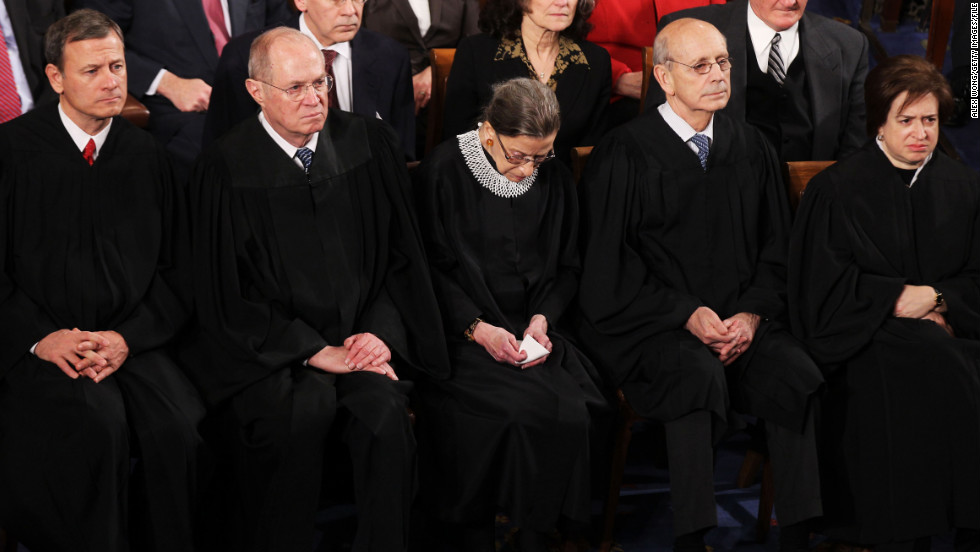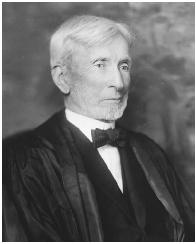The Court had two days of oral argument last week.
Tuesday, January 16
On Tuesday, the Court heard arguments in Dalmazzi v. United States and Hall v. Hall.
In Dalmazzi (consolidated with Ortiz v. United States and Cox v. United States), the justices considered whether a military judge is statutorily or constitutionally precluded from serving on a military court of criminal appeals (“CCA”) while simultaneously serving an appointment to the United States Court of Military Commission Review (“CMCR”), a statutorily created entity that hears appeals from military commissions. Petitioner Nicole A. Dalmazzi was convicted by a military judge of using Ecstasy, a Schedule I controlled substance. The U.S. Air Force CCA affirmed the findings and sentence of Dalmazzi’s dismissal and confinement for one month. Colonel Martin T. Mitchell participated as a judge on the CCA panel while also appointed as a judge to the CMCR. Dalmazzi (and petitioners in the consolidated cases) believes she is entitled to a new hearing before the CCA because Mitchell’s dual position on the CCA and the CMCR violated statutory and constitutional prohibitions on dual-officeholding, specifically 10 U.S.C. §973(b), a Civil War-era dual officership ban, and the Appointments Clause of Article II of the Constitution.
This case presented “unusual terrain” for the Supreme Court, Ariane de Vogue of CNN noted, because it was brought by military service members. The Court has not addressed such a case in 21 years.
Brian Fletcher, assistant to the U.S. Solicitor General, argued on behalf on the government. The federal statute cited by Dalmazzi, 10 U.S.C. §973(b), does not apply in this case, he argued. It precludes military officers from concurrently holding a “civil office” requiring presidential nomination and Senate confirmation, but the CMCR is not subject to §973(b) because it is a military office. The CMCR “performs a function that military officers have long performed, judging violations of the law or war or other offences triable by military commission,” he told the Court.
Stephen Vladeck, a law professor at the University of Texas School of Law, argued for the petitioners. He countered that the CMCR is a civil office subject to the dual-officeholding prohibition. Congress “created the office by statute,” he explained, “it exercises the sovereign authority of the United States,” and “ it can be held, and, indeed, is held by civilians.”
The Court also gave University of Virginia law professor Aditya Bamzai the opportunity to present his rather striking argument that the Supreme Court should not even be hearing the case. The Court lacked Article III jurisdiction in the case, he argued, because the Court of Appeals of the Armed Forces (“CAAF”), the entity that denied Dalmazzi’s petition for a grant of review of the CCA decision that she is appealing here, is an entity of the Executive Branch and not an appellate court. Justice Ginsburg questioned whether the fact that the CAAF exercises appellate jurisdiction over CCA gave the Supreme Court Article III appellate jurisdiction in the case. Bamzai responded that for constitutional purposes, the Court would be exercising original jurisdiction over a CAAF decision in this case, as it would be the first time an Article III court reviewed its decision. And the Constitution prohibits original jurisdiction in this situation.
In Tuesday’s other case, Hall v. Hall, the Court considered whether, in a single-district consolidated case, the entry of a final judgment in one case makes that case immediately appealable, even if other consolidated cases are still pending in the same district. Petitioner Elsa Hall, acting as the representative of her mother’s estate, pursued an action against her brother, Samuel Hall, who, in turn, filed a separate cause of action against Elsa. The two suits were separately filed in the District Court of the Virgin Islands, which were consolidated pursuant to Federal Rule of Civil Procedure 42(a)(2), which allows the consolidation of cases with “common questions of law or fact.”
Andrew Simpson, representing the petitioner, argued that the Court should adopt a bright line rule for considering consolidated cases, and that when a final judgment in one case is entered, even if other consolidated cases are still pending, the final judgment creates the right for a party to appeal that judgement. He also argued that Rule 42, the mechanism by which the two cases were consolidated, does not merge cases. Justice Kagan challenged Mr. Simpson on his interpretation of the word “consolidate.” “I mean, if you look at Black’s Law Dictionary, it says a consolidation in civil procedure, it defines as the court-ordered unification of two or more actions into a single action. So that’s the Black’s Law Dictionary definition. Same thing. Two becomes one.”
Neal Katyal, representing the respondent, argued that the two cases were consolidated for all purposes, and that when the petitioner attempted to appeal the final judgment in one case, while the respondent’s case against her was still pending, her “maneuver [ran] headlong into determinations by both Congress and this Court that litigants can only appeal generally from final decisions.”
Chief Justice Roberts wondered about the impact of the respondent’s position in a “mass tort situation” in which there are “100 separate cases.” In these cases, parties might have to wait years for final judgments in all of the consolidated cases in the same district before filing appeals, a delay, the Chief Justice noted, that could be “very prejudicial.” Katyal responded that parties in this type of situation could rely on interlocutory appeals, writs of mandamus, and Federal Rule of Civil Procedure 54, which allows a district court to use its discretion to send a case up to the court of appeals.
Wednesday, January 17
On Wednesday, the Court heard arguments in Encino Motorcars v. Navarro, which presents the question of whether service advisors at car dealerships are exempt under 29 U.S.C. §213(b)(10)(A) from the Fair Labor Standards Act’s overtime-pay requirements.
Paul Clement argued for Encino Motorcars. Clement made a text-based argument that service advisors are “salespeople primarily engaged in servicing automobiles,” and they are therefore within the FLSA exemption for any salesman, partsman, or mechanic primarily engaged in selling or servicing automobiles, trucks, or farm implements. Justice Kagan challenged Clement by pointing out that most dictionaries define “servicing” automobiles as “repairing, maintain, fixing,” to which Clement responded that Congress intended courts to interpret “servicing” broadly because the exemption includes partsmen, who “are not engaged in getting under the hood and turning the wrenches.”
James Feldman argued on behalf of the respondent service advisors. Feldman also used a text-based argument, claiming that five English dictionaries define “service” as maintaining or repairing. “You don’t maintain or repair a car, in the way people would ordinarily speak, with a pad or a clipboard and a pencil or a telephone, which are the primary tools that service advisors use,” he said. Chief Justice Roberts challenged Feldman by pointing out that service advisors sometimes make cursory checks of cars and make quick diagnoses before sending the cars to mechanics or partsmen, who frequently repair the cars according to the service advisors’ diagnoses. Feldman allowed that service advisors might “make a guess” based on what customers tell them, but this was not servicing the car. When Justice Kennedy asked whether it would be accurate for a service advisor to tell a customer that he is going to supervise the servicing of the car, Feldman replied that such an explanation would be incorrect: they “serve a communications function. They don’t in any sense supervise the mechanic.”
The National Law Journal noted that Justice Kagan wondered why the United States Solicitor General wasn’t part of the arguments considering this was a case “in which one would expect the government to be here.”
Also on Wednesday, the Court heard McCoy v. Louisiana, which presents the question of whether it is unconstitutional for a defense lawyer to concede his client’s guilt over the accused’s express objection. Seth Waxman argued on behalf of Robert McCoy, who was accused of triple murder. Waxman argued that McCoy’s previous lawyer had violated the Sixth Amendment by telling the jury that McCoy was guilty. Chief Justice Roberts and Justice Breyer challenged him on whether a lawyer may admit that his client committed any element of an offense over a client’s objection. Waxman, after being pressed, argued that a trial court should not allow a lawyer to admit that his client committed any element of an offense against the client’s wishes. Justice Breyer suggested that such a stance presents a slippery slope, or as he put it, a balloon, “expanding into we don’t know where what, because they’re filled with elements, the federal code. And before you know it, lawyers will have a hard time defending this person. And you’re walking right into jail when you start telling your lawyer how to run his case.” Waxman responded that the Court does not need to decide whether a lawyer may admit any element of an offense in order to decide the case before them. Justice Breyer noted that “there are about 200,000 criminal cases in the lower courts” and he wondered about the “kind of chaos” that would result, since “there are many, many defendants who go through dozens of lawyers while they’re objecting to this one or that one or the other one.”
Elizabeth Murrill, Solicitor General of Louisiana, argued for the state. She proposed a rule that in a narrow class of death penalty cases lawyers may be required to override their clients regarding trial strategy. When the strategy the client proposes is “a futile charade and requires him to defeat both their objectives of defeating the death penalty,” such a rule should be applied. Indeed, Murrill suggested, a lawyer’s cooperating with such an ineffective strategy would meet the standard for ineffective assistance of counsel. Challenged by Justice Sotomayor as to why the proposed rule should apply only to death penalty cases, Murrill argued that in most cases the rules of professional conduct mandate that an attorney follow his client’s wishes. Several justices pushed back on this point, arguing that the decision of whether to admit guilt in a capital case should be left in the hands of the client and not the lawyers.
This post was drafted by ISCOTUS Fellows Bridget Flynn and Elisabeth Hieber, both Chicago-Kent Class of 2019, and was edited by ISCOTUS Editorial Coordinator Anna Jirschele, Chicago-Kent Class of 2018 and ISCOTUS Co-Director Christopher Schmidt.




